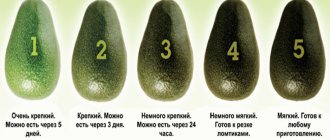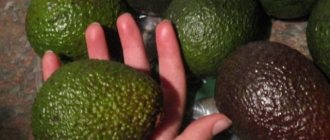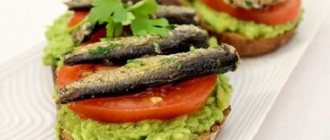Once ripened, you have a narrow window of time—usually a few days—before the fruit begins to spoil ().
You may be wondering how to tell when an avocado has gone bad and is no longer ready to eat.
Here are 5 signs that your avocado has gone bad.
How do you know if an avocado has gone bad?
Overly soft with bruised skin
When checking for ripeness, use the palm of your hand to gently squeeze the avocado. Do not press the fruit with your fingers as this may damage the flesh.
If the avocado is very hard and cannot be pressed at all, it means it is unripe. If it gives a little, it's probably ripe and ready to eat.
However, if squeezing leaves small indentations, the fruit may be too ripe to cut and would benefit from being pureed.
The fruit is overripe and probably spoiled, perhaps if pressure leaves large dents and the fruit becomes soft.
Also, if the avocado already has dents in it before you squeeze it, it has probably already started to go bad ().
Summary:
If you gently squeeze an avocado in the palm of your hand and it forms large indentations where you pressed, the fruit is overripe and likely spoiled.
Is it possible to eat avocado if it tastes bitter?
Unripe or overripe fruit usually tastes different. Overripe fruit compensates for the bitterness with an oily and soft texture.
An unripe avocado will be bitter inside to such an extent that it will simply be impossible to enjoy eating it. Bitterness does not mean that the fruit loses its beneficial properties or becomes harmful: it is just a sign of the level of ripeness and a characteristic of taste.
Blackened peel
Some avocados undergo distinct changes in skin color as they ripen, especially the Hass variety, which accounts for about 80% of avocados eaten worldwide ().
When Hass avocados are not fully ripe, they have a bumpy, bright green skin. When ripe, it turns dark green or brown. If the skin looks almost black and the fruit feels soft when touched, it is overripe and probably spoiled.
Other varieties, including Zutano and Fuerte, retain their green skin color no matter how ripe they are. Use other methods, such as feeling for firmness, to determine whether they are ripe or spoiled.
Summary:
Hass, the most common variety of avocado, has blackened skin when overripe or spoiled. However, other varieties retain their green color when overripe.
Dark, striped flesh
Once you cut an avocado, it's much easier to tell if it's gone bad. Of course, this option is only suitable if you have already bought the fruit.
Avocados that are ready to eat have light green flesh. Rotten pulp has brown or black spots ().
However, an isolated brown spot may be due to dents rather than widespread deterioration and can be cut off.
Another possible sign of rotting is dark streaks in the flesh.
However, some avocados, especially those picked from young trees, may have dark streaks even if they are not rotten. If the fruit looks good and does not taste bad, it is safe to eat.
Likewise, the texture of an avocado can be uneven when it's spoiled. However, if there are no other signs of rot, this is not necessarily a bad thing. The fibrous texture can also be attributed to growing conditions ().
Summary:
Spoiled avocado flesh has dark spots and a streaky texture that tastes bad. However, isolated areas of discoloration may be associated with dents.
What Causes Avocado Leaves to Dry? — 4 main reasons
At home, drying and blackening of avocado leaves occurs for a number of different reasons. The main ones are:
Inappropriate growing conditions
This reason is the most common. A tropical plant requires a warm room with good lighting and sufficient humidity (60%). Dry air will cause the leaves to curl and dry out. In poor lighting, the plant will have little light for photosynthesis, and as a result, the leaves will turn yellow and fall off. But there should be no direct exposure to sunlight, which can cause burns on the leaves.
Illiterate care
Both overdrying and waterlogging of the soil are detrimental to the tree. Leaves can dry out and fall off from cold drafts or from the use of cold water for irrigation. Caking and compaction of the soil in the pot is not allowed; it should be kept loose and moist.
The pot itself for planting an avocado must be of suitable size: it may not be very large in width, but it must be deep so that the root system can grow in depth, as this is typical for it. As soon as the root rests on the bottom of the container and there is nowhere for it to develop, the leaves begin to dry out and fall off.
Harmful insects
Avocados are often attacked by two main pests - spider mites and scale insects, which feed on the juices of the plant. Their effect is the same: after contact with the trunk and leaves of an avocado, these parasites multiply very actively, which subsequently provokes yellowing and shedding of foliage. This is extremely harmful for the plant itself, since after such an infection it quickly dies. Dry air favors the proliferation of parasites.
To effectively control pests, the air must be humidified. Also, it should be remembered that these insects easily move from one plant to another. Because of this, trees that are already sick need to be isolated from healthy ones. In order to destroy pests, drugs such as Actofit and Vermitek are effective.
Diseases
In a favorable climate, avocados are rarely affected by various diseases. But with reduced immunity (when the plant is kept in an unsuitable environment), it can quickly get sick. In indoor conditions, the most common diseases are fungal infections. They occur due to improper watering of the plant. When there is powdery mildew (a whitish coating on the leaves), the lower leaves of an avocado are the first to dry out and fall off.
To eliminate this problem, they resort to the use of fungicides (Topaz, Strobi), the plant is sprayed with a soap solution with the addition of soda or potassium permanganate, the affected leaves are completely removed, and the upper part of the soil is replaced with a new one. Late blight and root rot are also common. The main reason is waterlogging and poor soil drainage. They primarily affect the condition of avocado leaves. The latter become covered with various spots, their ends darken and dry out. To cope with these diseases, you need to treat the soil and plant twice with fungicides (for example, Fitolavin, Ridomil).
By taste or smell
Ripe avocados have a pleasant, slightly sweet aroma and a slightly nutty taste. As the fruit spoils, its taste and smell may deteriorate.
If it tastes or smells sour, it may have bacterial spoilage and should be discarded ().
A chemical smell and taste may mean it is rancid. This can happen when oxygen or microbes damage or break down the fruit's unsaturated fat ().
Rancidity can lead to the formation of potentially toxic compounds. Don't eat an avocado if you think it's rancid ().
The taste of spoiled avocados can vary, but it's usually easy to tell if they've gone bad based on the taste.
You can tell if an avocado has gone bad by smell, taste, touch, and visual inspection.
Summary:
A sour taste or smell, as well as a rancid aroma and chemical taste mean the avocado is spoiled and you should discard it.
The benefits and harms of avocados for the body
Dark green fruits with a rough skin and a pit inside contain fiber, potassium, vitamins B, K, E, C (one fruit contains 50% of the norm), as well as folic acid (it reduces the risk of congenital anomalies in the unborn child).
The pulp of a ripe avocado has a delicate, oily consistency with a high content of vegetable fats and tastes like a walnut.
In terms of nutrients and minerals, avocados can be compared to pharmacy multivitamins.
This rich chemical composition of avocado lowers cholesterol levels in the blood, strengthens the immune system and bones, helps lose weight, normalizes blood circulation, and increases performance.
In the summer, one of the most popular and healthy drinks is an avocado smoothie with almond milk. Photo: Restaurant Christian
However, the overseas fruit is not only useful, but also has contraindications. Who shouldn't eat avocado?
- Firstly, for allergy sufferers. Especially those who have a strong reaction to citrus fruits. Experts recommend that such people either first take a test for tolerance to the fruit, or include it in the diet gradually, observing the body.
- Secondly, people suffering from gastrointestinal diseases should refrain from eating avocados. In this case, it is also recommended to consult your doctor. Avocados are high in fat, which can negatively affect the digestive system.
- Thirdly, diabetics should treat avocados with caution - 100 grams of this product contains approximately 8.5 grams of carbohydrates.
You can prepare a large number of delicious dishes from avocados, but before eating this overseas fruit, you first need to find out if you are allergic to it. Photo: Restaurant “Syrovarnya”
Mold
Mold on avocados is usually white or gray and has a fuzzy appearance. Do not inhale it, as you may inhale mold spores and cause breathing problems if you are allergic to it.
Avoid buying avocados with mold on the outside, as it can penetrate into the flesh and cause the entire fruit to spoil.
If you cut an avocado and see mold, discard the entire fruit. Although you may only see mold in one area, it can easily spread through the pulp. Do not try to save the fetus ().
Summary:
Mold is a clear sign that the avocado has gone bad. You should discard the entire fruit as mold may spread through the flesh but may not be completely visible.
Safety of overripe avocados
Whether an overripe avocado is safe to eat depends on the type of decomposition and how long it remains overripe.
Since ripening begins at the end of the stem and progresses downwards, you can use part of the overripe fruit if the flesh has just begun to brown.
However, do not eat the discolored parts of the avocado as they will not taste good. Also, do not attempt to salvage any part of a rancid, sour-smelling, or moldy avocado, as this may make you sick (, ,).
Keep in mind that once you cut an avocado, the flesh will begin to brown due to exposure to oxygen. This is a natural process similar to how apples turn brown when sliced. If you find it unappetizing, peel off the brown layer and eat the rest ().
To minimize darkening of cut areas, brush the pulp with lemon juice and store in the refrigerator in a sealed container.
By keeping an eye on your avocado and storing it in the refrigerator to slow down the ripening process, you can reduce waste.
Overly soft but unspoilt avocados are safe to eat and can be used in guacamole, smoothies, salad dressings and baked goods.
Summary:
If an overripe avocado tastes great, you can eat it, but be sure to avoid spoiled ones. The more an avocado deteriorates, the more likely it is to become rancid or moldy, which can make you sick.
How to replant correctly
When replanting, there is no need to completely change the soil in the containers, since the thin and small roots in the root system are damaged. They must absorb water and liquid nutrition. Complete soil replacement is carried out:
- when salts accumulate in it due to watering with hard water;
- with a deficiency of microelements and nutrition;
- when the roots are squeezed by the walls of a bowl, flowerpot, or pot;
- in case of diseases of the roots, the appearance of pests in them.
The plant is removed from a pot with a damp lump of earth and placed in a larger one 10-15 cm in height and 2-3 cm in diameter. Buy a container for the culture, taking into account the fact that after transplanting the tree’s roots rapidly begin to grow downwards, and when reaching the bottom, bend over. Therefore, the leaf blades begin to turn yellow.
If the leaves of the transplanted plant continue to dry out, then:
- cover the bowl with the plant with a greenhouse made of a plastic bag without touching the leaves;
- spray the plant at least 2 times a day to maintain a high level of air humidity in the greenhouse, while adding Epin to the water once every 7-8 days;
- reduce soil watering to a minimum, since in the greenhouse it remains wet for a long time;
- cover the greenhouse with the sprout from direct ultraviolet radiation to avoid burns;
- ventilate the plant by removing the bag while spraying or watering the soil, and also lift the bag additionally 1-2 times for 1-2 minutes for air exchange.
Note! With regular waterlogging, the roots begin to rot, and if grown in a pot that is too loose, they will not occupy the entire area, so the soil will not dry out quickly and moisture will accumulate. Excess moisture is removed, as mentioned above, by wrapping the clod of earth with the plant in newsprint.
Soil and fertilizers
Soil for culture can be purchased at the store or prepared independently. Garden soil, river sand and humus are mixed in equal parts by weight. It is not recommended to add peat as it makes the soil acidic. In order for the tree to grow well, Sphagnum is added to the soil.
It is best to replant the tree in the spring as it transitions from dormancy to growth. The plant is fed every other day, but before that it is watered abundantly. Further liquid mineral fertilizing for decorative foliage and indoor crops is carried out from March to October along with watering. Initially, the dose of water is doubled by the dose of the drug according to the instructions to avoid burning the roots. If it is clear that the plant is comfortable, then subsequent feeding should correspond to the concentration according to the instructions.
Feeding begins 30 days after replanting, since the tree will have enough of the necessary components in the new substrate. In case of deficiency:
- nitrogen - the sprout will have small leaves;
- magnesium - the leaves will be pale and the veins will be dark;
- phosphorus - the edges of the plates will darken.
Summarize
- An avocado is spoiled if it is soft when squeezed, brown or moldy inside, and it tastes rancid or smells sour.
- You can salvage some of the fruit if it is just starting to brown inside, but the rest of the fruit looks and smells and tastes great.
- Inspect your avocado carefully in the store and keep a close eye on it at home to avoid having to throw it away.
Tags: Avocado
About the author: Alexander Fedorov
Candidate of Biological Sciences, biologist, nutrition expert. Graduated from Stavropol State University with a degree in Biology at the Faculty of Biology and Chemistry.
- Related Posts
- Hawthorn: beneficial properties and contraindications
- 11 Health Benefits of Yuzu Citrus Fruit
- Persimmon: benefits and harm to the body, contraindications
« Previous entry











